News
Early morning horror as villagers wake up to chemical fumes
“In the early hours of Tuesday (October 22) we were woken by neighbours who were banging on our door and windows and

K.D.A. Aruna: This is not the first time
shouting for us to come out. When my husband opened the door the house was filled with smoke and a strong smell and we began to choke,” 23-year-old Samanthika Priyadharshani said.
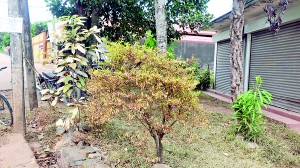
Leaves had withered and turned yellow. Pix by Ranjith Perera
It was 2.30 a.m. and residents of Batakeththara-Piliyandala began to panic as fumes accompanied by a strong odour from a detergents producing factory in the vicinity began to spread.
It was later revealed that it was an ammonia gas leak from the factory that produces hand wash, car wash and other detergent for the export market.
Recently married Samanthika, who lives very close to the factory said she was wracked by a bout of continuous coughing and found it difficult to breathe and even developed chest pain. Since it was still very dark she said they couldn’t see from where the smoke was emanating. But when she and others in the vicinity were rushed to hospital they realizsed the fumes were coming from the factory and some residents felt dizzy and others almost fainted when they passed the factory premises.
“We were immediately transferred from the Piliyandala hospital to Kalubowila. I thought I would die as I was finding it increasingly difficult to breathe and the chest pain became unbearable. Although I was given an oxygeon mask I really
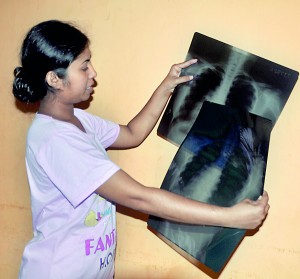
Samanthika shows her x rays
thought I may not survive,” she said showing her chest x rays.
She said the wards in Kalubowila Hospital began to fill up and there were three patients to a single bed.
The Sunday Times witnessed the effects of the strong chemical on houses when we visited
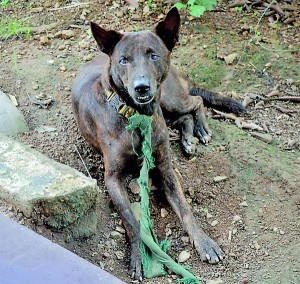
The dog that was badly affected
the affected area. White spots were seen on the floors and walls of the houses and the strong smell still persisted. Villagers complained that their clothes and other household items too had been affected.
The grass and other plants had turned yellow and were dried up and withered. Dead frogs were seen alongside the roads while the dogs appeared to have sustained rashes. One dog that was in the factory premises had patches of blue and it had eventually gone blind.
K.A.D Aruna, another resident from the area complained that this was not the first time they had experienced problems due to chemical exposure from the factory.
He said on and off a foul odour emanated from the factory while charging that waste material from the factory was released in to the drains. He said during the rainy seasons these drains overflowed posing a health hazard.
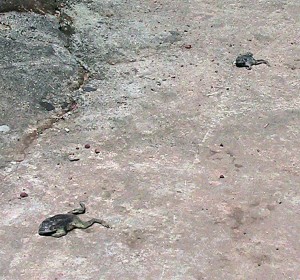
frogs that were found dead on the roadside
Three days after the incident residents were still wearing masks to ward off the smell and some complained of skin irritations.
Aruna also charged that the water in about 14 wells in that area had been contaminated by chemicals from the factory. A dejected Aruna said in 2009 although the villagers filed legal action against the factory for polluting the environment, their efforts did not succeed.
“We were advised to re-file the case, but we lacked the finances to do so.
Other villagers The Sunday Times spoke to also complained that authorities had turned a blind eye to their complaints and who ever supported the villagers to take a stand against the factory were bought over.
While the villagers were telling their tales of woe a mother of a 16-year-old boy rushed up to us and said her son had to be re-admitted to hospital while he was at school as he continued to vomit.
“My son received treatment following the incident and returned home. But he continued to vomit,” she said.
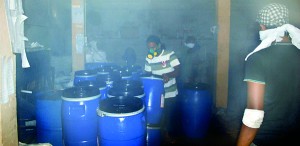
On the day of the leak: A scene at the factory. Pic by Reka Tharangani
Villagers have urged authorities to take action against the factory as they charge they are playing with the lives of human beings. They said a family living in a house right next to the factory sold their house a couple of years ago as they found it hazardous to live there due to the chemical fumes. They sold the house to the factory.
On the day of the ammonia leak 32 residents were admitted to the Piliyandala hospital while 72 received treatment at the Kalubowila Hospital according to hospital sources.
Meanwhile the Kesbewa Urban Council has provided water tanks to the villagers for drinking purposes.
| Expert committee focuses on preventive measures
The head of the expert committee appointed by Environment Minister Susil Premajayantha to probe the Piliyandala gas leak said yesterday they would submit a report with recommendations to prevent similar industrial accidents in factories dealing with chemicals. The Committee head and Central Environment Authority Director General, Saranga Alahaperuma, said the committee members at their first meeting on Thursday decided that in addition to their observations on the Piliyandala incident, the report should also include recommendations to prevent such accidents in the future. The four-member committee comprising officials from the Central Environmental Authority (CEA), the University of Moratuwa, the Industrial Technology Institute (ITI) and the Ministry of Health is expected to submit its report to Minister Premajayantha by November 7. “We are collecting samples of chemicals and relevant data for our investigations,” Dr. Alahapperuma said. Asked why a licence was issued to the factory located in a residential area, Dr. Alahapperuma said the location was not considered an urbanised area when the factory was established in 1996. He said the CEA’s field officers had been carrying out checks on this factory every three months and submitting reports. Meanwhile, Police Spokesman Ajith Rohana said the Kesbewa Magistrate Court had issued an interim order to close the factory until November 8 and the owner of the chemical factory had been barred from leaving the country. |

